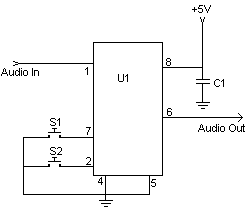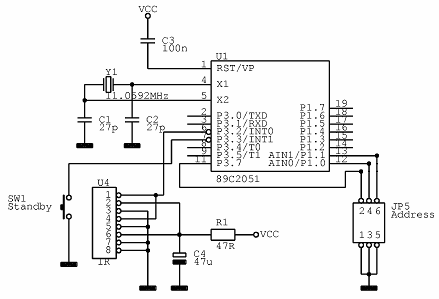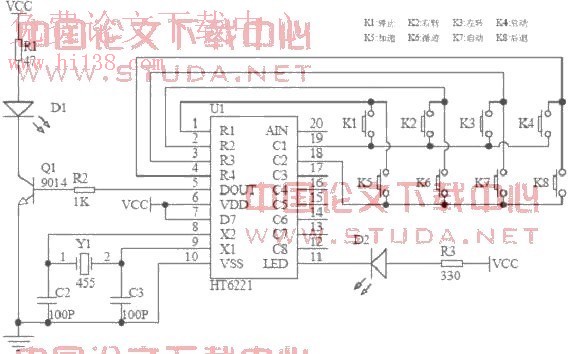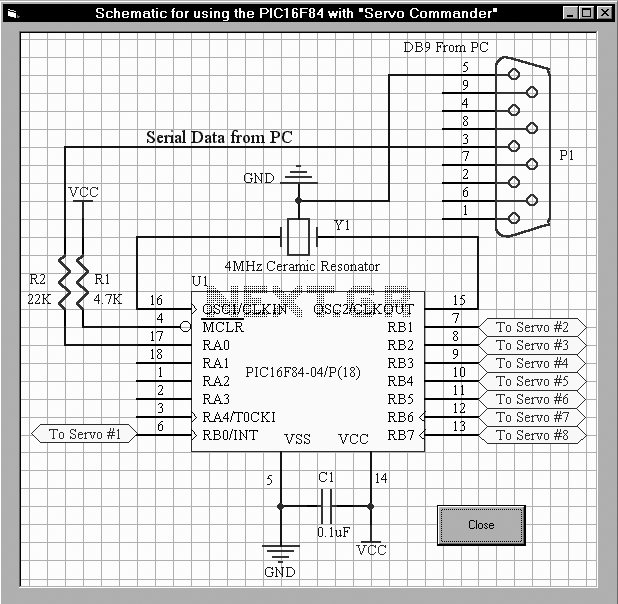
Digital Volume Control with DS1669

This digital volume control has no pot to wear out and introduces almost no noise in the circuit. Instead, the volume is controlled by pressing UP and DOWN buttons. This simple circuit would be a great touch to any home audio project. More: 1. U1 is available from Dallas Semiconductor. 2. S1 turns the volume up, S2 turns it down. 3. The input signal should not fall below -0.2 volts. 4. Using a dual polarity power supply (+-5V works fine) will cure most clipping problems. You will have to
The described digital volume control circuit utilizes a microcontroller or a digital potentiometer (U1) sourced from Dallas Semiconductor. This component is responsible for adjusting the audio signal level without the mechanical wear associated with traditional potentiometers. The volume adjustment is facilitated through two momentary push-button switches: S1 for increasing volume and S2 for decreasing volume.
The circuit requires careful consideration of the input signal range, with a minimum threshold of -0.2 volts to ensure proper operation. This limitation is critical to prevent distortion or clipping of the audio signal. To mitigate clipping issues, the circuit should be powered by a dual polarity power supply, typically providing +5V and -5V. This configuration enhances the dynamic range of the audio signal and helps maintain signal integrity throughout the volume adjustment process.
In designing the circuit, it is essential to incorporate proper debouncing techniques for the push buttons to prevent erroneous volume changes due to mechanical bouncing. Additionally, the output stage should be designed to handle the expected load impedance of the audio system, ensuring compatibility with various audio devices.
Overall, this digital volume control circuit presents a modern solution for audio applications, combining reliability and low noise operation, making it suitable for integration into home audio projects or other electronic audio systems.This digital volume control has no pot to wear out and introduces almost no noise in the circuit. Instead, the volume is controlled by pressing UP and DOWN buttons. This simple circuit would be a great touch to any home audio project. 1. U1 is available from Dallas Semiconductor. 2. S1 turns the volume up, S2 turns it down. 3. The input signal should not fall below -0.2 volts. 4. Using a dual polariity power supply (+-5V works fine) will cure most clipping problems. You will have to 🔗 External reference
The described digital volume control circuit utilizes a microcontroller or a digital potentiometer (U1) sourced from Dallas Semiconductor. This component is responsible for adjusting the audio signal level without the mechanical wear associated with traditional potentiometers. The volume adjustment is facilitated through two momentary push-button switches: S1 for increasing volume and S2 for decreasing volume.
The circuit requires careful consideration of the input signal range, with a minimum threshold of -0.2 volts to ensure proper operation. This limitation is critical to prevent distortion or clipping of the audio signal. To mitigate clipping issues, the circuit should be powered by a dual polarity power supply, typically providing +5V and -5V. This configuration enhances the dynamic range of the audio signal and helps maintain signal integrity throughout the volume adjustment process.
In designing the circuit, it is essential to incorporate proper debouncing techniques for the push buttons to prevent erroneous volume changes due to mechanical bouncing. Additionally, the output stage should be designed to handle the expected load impedance of the audio system, ensuring compatibility with various audio devices.
Overall, this digital volume control circuit presents a modern solution for audio applications, combining reliability and low noise operation, making it suitable for integration into home audio projects or other electronic audio systems.This digital volume control has no pot to wear out and introduces almost no noise in the circuit. Instead, the volume is controlled by pressing UP and DOWN buttons. This simple circuit would be a great touch to any home audio project. 1. U1 is available from Dallas Semiconductor. 2. S1 turns the volume up, S2 turns it down. 3. The input signal should not fall below -0.2 volts. 4. Using a dual polariity power supply (+-5V works fine) will cure most clipping problems. You will have to 🔗 External reference





